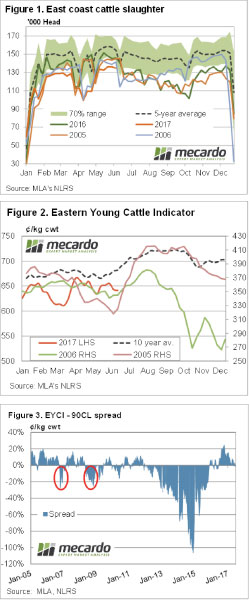What to expect if it stays dry
 Whether or not you believe the Bureau of Meteorology (BOM) three month forecast, there is always the chance the current dry spell could continue. Dry winter’s and springs are not great for cattle prices, but given the current historically strong values, how bad could it get?
Whether or not you believe the Bureau of Meteorology (BOM) three month forecast, there is always the chance the current dry spell could continue. Dry winter’s and springs are not great for cattle prices, but given the current historically strong values, how bad could it get?
The usual impacts of a dry winter and spring are relatively predictable. Cattle producers usually hold out on selling cattle until past the point of no return, while grain prices inevitably rise. Come mid spring there is a rush to offload stock, while demand has weakened, leaving prices in freefall.
To work out where prices might end up, we can take a look historical slaughter during dry times, and associated prices. Obviously fundamental price levels have changed somewhat since the most recent dry spring, but we can try and account for this and come up with a base level for cattle prices.
The 2005 and 2006 seasons are a reasonable template for the market to follow. In 2005 cattle markets reached record highs on the back of strong demand, and a herd rebuild restricting supply. The following year saw cattle supply track in much the same way, before diverging in mid-August (figure 1).
For the last five months of 2006, slaughter was up 16.5% on 2005 levels. The impact on price was dramatic. The Eastern Young Cattle Indicator (EYCI) peaked in mid-August, and as the dry set in, subsequently fell 25.1% to bottom out twice, in October and December.
We can’t really use a 25% fall as the benchmark for price declines in a dry winter or spring. But we can use the 90CL price, and the discount the EYCI reaches, to estimate how low prices might go. Figure 3 shows the long term EYCI spread to the 90CL Frozen Cow Indicator. Before the massive discounts of 2013-2016, the biggest the EYCI got to the 90CL was 20%.
Key points:
- There are some concerns emerging on around dry weather which could possibly continue.
- Historically a dry winter and spring has resulted in a strong increase in cattle supply.
- If the EYCI moves to a historical dry winter/spring discount, values could fall by 130-150¢.
What does this mean?
Figure 3 shows a few dry winter/spring periods when the EYCI has fallen relative to the 90CL indicator. Currently the EYCI is basically at parity with the 90CL price, and a 20% fall would shave 130¢ off the current value. Based on the current 90CL price of 648¢/kg, a 20% discount would give an EYCI of 518¢/kg cwt.
If the EYCI falls into the low 500¢ it would be the weakest price in two years. There is also a chance the 90CL could fall, which would obviously mean cattle prices could weaken further.
It could rain, and cattle prices could hold on to current strong values, but if the rain holds off cattle prices will fall significantly. This could be good enough reason for some to take the money on offer at the moment.
Other comments:
Include here any additional information or specific comments to ensure successful upload by the web manager


